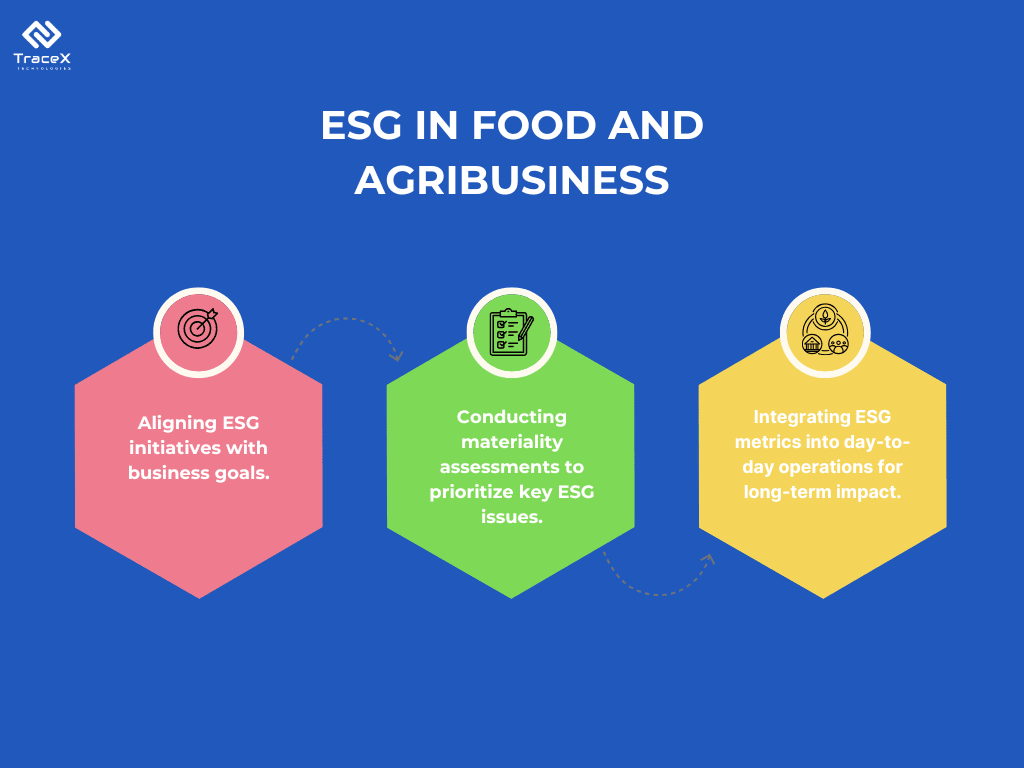Contact: +91 99725 24322 |
Menu
Menu

With consumers demanding transparency and investors prioritizing sustainable practices, companies face mounting pressure to prove their ESG credentials. Environmental, Social, and Governance (ESG) principles are transforming the food and agribusiness sector, driving companies to adopt more sustainable, socially responsible, and transparent practices. This ESG guide for food and agribusiness explores the role of ESG in agribusiness, the impact of ESG on food production, best practices for ESG reporting, and how advanced technology solutions can streamline ESG compliance.
With nearly 8 billion inhabitants, our planet has a significant number of mouths to feed. According to United Nations population forecasts, this figure could peak at 9.7 billion by 2050. The food and agriculture sector, responsible for meeting our dietary needs, confronts hurdles as we seek greater production levels.
But achieving this is easier said than done. Managing everything from sustainable sourcing to carbon footprint reduction can feel overwhelming. How do you balance profitability with sustainability? This guide breaks down the complexities, offering practical strategies to integrate ESG into your business model and stay competitive in the market.
Key Takeaways
When it comes to the food and agribusiness sector, Environmental, Social, and Governance (ESG) factors are more than just buzzwords—they’re a vital part of doing business today. But what exactly is ESG, and why should it matter to your operations? Simply put, ESG refers to the set of standards that measure a company’s impact on the environment, its social responsibility, and how it is governed. In agribusiness, this means focusing on sustainable practices, fair labor conditions, and ethical decision-making.
Research from the U.N. Food and Agriculture Organization (FAO) indicates that 31 percent of emissions from human activities are attributed to the food and agriculture sector. As the global community strives for net-zero emissions by 2050, this industry has become a focal point for policymakers and regulators.
Because consumers, investors, and regulators have become increasingly conscious of where their food comes from, how it’s produced, and the impact it has on the planet. They want transparency, and companies that don’t meet these expectations risk falling behind. From reducing carbon emissions to improving worker conditions, integrating ESG can help you stay relevant and competitive.
Managing ESG in this sector isn’t without its challenges. The industry faces unique issues like ensuring sustainable farming practices, reducing water consumption, and managing supply chain transparency. Plus, there’s the pressure to keep up with evolving regulations and maintain profitability while adopting greener practices.
Today’s market is driven by conscious consumers who care deeply about the planet, as well as investors looking for sustainable growth. Meanwhile, governments are setting stricter rules to ensure food production doesn’t come at the expense of the environment. Meeting these expectations is not just about compliance—it’s about building a resilient, forward-thinking brand that can adapt to future challenges. By diving into ESG, food and agribusiness companies can tap into a growing market, secure long-term investment, and create a positive impact on the world.
Sustainable farming is all about using practices that conserve resources like water and soil. Techniques such as drip irrigation help manage water efficiently, while cover cropping improves soil health by adding organic matter and preventing erosion. These methods help farms be more resilient to climate change and use resources wisely.
Technology like precision agriculture tools and data-driven monitoring systems can help farmers minimize their carbon emissions. For instance, using sensors and drones, farmers can monitor crop health and optimize fertilizer use, leading to lower emissions and less waste. Blockchain-based platforms ensure transparency in the entire supply chain, allowing stakeholders to track their impact on the environment.
Smallholder farmers play a vital role in the global food supply, but they often face challenges like low incomes and lack of access to resources. Supporting these farmers through fair trade practices, training, and better market access can significantly improve their livelihoods. Fair labor practices, like providing safe working conditions and fair wages, are essential to building a more ethical food system.
Engaging with local communities is more than just good practice—it’s good business. When companies invest in education, healthcare, and local infrastructure, they strengthen their relationship with the communities that support their operations. This kind of engagement also positively impacts brand reputation, as consumers today expect businesses to contribute positively to society.
In agribusiness, transparency is crucial for ensuring supply chain traceability. It allows businesses to monitor how products are grown, processed, and transported. When a company is transparent about its operations, it builds trust with consumers and partners, leading to stronger relationships and a more resilient business.
Ethical sourcing is all about making sure that products are produced in ways that respect workers’ rights, environmental standards, and fair trade principles. For example, sourcing coffee or cocoa from farmers who are paid fairly and follow sustainable farming practices helps improve the quality of life in farming communities. It also boosts the company’s image among consumers who care about ethical consumption, ultimately benefiting the brand.
Strong governance practices make a company more appealing to investors. When a company shows that it adheres to ethical guidelines and is committed to transparency, it instils confidence in its stability and long-term vision. Investors see this as a sign of lower risks and are more likely to support such businesses. Furthermore, robust governance can open doors to new markets, especially where regulations around ethical sourcing and sustainability are strict. This makes good governance a strategic advantage in today’s market.
Integrating ESG practices in agribusiness is not just about being sustainable—it’s about creating long-term value. Here’s how each aspect plays a role:
Sustainable farming, efficient water use, and reducing carbon emissions are key to improving ESG ratings. When agribusinesses manage their resources wisely, it helps maintain soil health, conserve water, and minimize pollution. These practices not only protect the environment but also ensure compliance with regulations and boost the company’s reputation among consumers and investors.
Agribusiness often relies on smallholder farmers and local communities. Supporting these farmers with fair pricing and access to resources is crucial. Additionally, ensuring fair labor practices, safe working conditions, and contributing to community development are core to the social aspect of ESG. These actions build trust and loyalty among communities and create a more stable, ethical supply chain.
Good governance means being transparent about your business practices, holding yourself accountable, and ensuring ethical sourcing of raw materials. This includes clear reporting, anti-corruption measures, and following ethical sourcing practices that align with consumer expectations. By doing so, agribusinesses can mitigate risks, build investor confidence, and strengthen their brand reputation.
By focusing on these ESG areas, agribusinesses can not only achieve better ratings but also ensure sustainable growth, create positive impacts, and stay ahead in a competitive market.
ESG in food production focuses on sustainable practices that reduce environmental impact, support fair labor conditions, and ensure ethical sourcing. It involves adopting traceability tools, minimizing waste, and using technologies to monitor supply chains for greater transparency.
In today’s market, consumers want to know where their food comes from and how it’s made. A sustainable food supply chain means making sure that from the farm to the dinner table, each step is eco-friendly and responsible. This includes practices like regenerative farming and minimizing carbon footprints during transportation.
A huge challenge for food producers is cutting down on waste. It’s not just about ethics; less waste means better ESG scores and lower costs. When food waste is reduced, it lessens the environmental impact, making operations more efficient and sustainable.
Traceability is key to ensuring the safety and quality of food. By keeping track of every stage in the production process, businesses can ensure that products meet safety standards and maintain high quality. This transparency builds consumer trust, boosts brand reputation, and aligns with the rising demand for ethically sourced products.
With these focus areas, food producers can improve their ESG performance while building stronger connections with conscious consumers.
ESG reporting is about disclosing a company’s environmental, social, and governance practices. For food and agribusiness companies, it’s crucial because it shows commitment to sustainability and social responsibility. This transparency builds trust with consumers, investors, and regulators, highlighting the company’s efforts to reduce environmental impact and support fair labor practices.
With many frameworks out there—like GRI (Global Reporting Initiative), SASB (Sustainability Accounting Standards Board), and TCFD (Task Force on Climate-related Financial Disclosures)—it’s important to pick one that aligns with your business goals and stakeholders’ needs. GRI is often broad and suitable for global companies, SASB focuses on industry-specific metrics, and TCFD is essential for addressing climate-related financial risks.
To create effective ESG reports, companies need a systematic approach to data collection. Start by identifying key metrics that matter to your stakeholders, like carbon emissions or water usage. Use technology to automate data gathering, ensuring accuracy. Measure your impact by comparing performance year over year, and be open about both successes and challenges. Transparency is key—an honest, well-documented report builds credibility and helps companies stay accountable to their ESG goals.
Technology is a game-changer for achieving ESG standards in food and agribusiness. Digital tools like blockchain ensure transparency by creating a secure, unchangeable record of every step in the supply chain. Satellite monitoring helps track environmental changes, like deforestation or crop health, in real-time. These technologies help businesses prove they’re meeting sustainability goals and managing risks effectively.
Digital MRV (Measurement, Reporting, and Verification) simplifies tracking of carbon emissions and sustainable practices. It automates data collection and analysis, providing accurate reports on carbon reductions or sustainability efforts. This verification is essential when businesses make claims about reducing their environmental impact or generating carbon credits, ensuring those claims are trustworthy.
Many agribusinesses are already using these tools to meet tough regulations like CSRD (Corporate Sustainability Reporting Directive), CSDDD (Corporate Sustainability Due Diligence Directive), and EUDR (EU Deforestation Regulation). For example, blockchain can track the sourcing of raw materials to ensure they’re deforestation-free, while satellite data helps monitor the impact of farming practices. These examples show how technology can simplify compliance while enhancing transparency and trust.

ESG investing in agriculture faces several challenges:
Technology plays a crucial role in overcoming the challenges of ESG investing in agriculture, helping to improve transparency, data accuracy, and risk management:
By addressing these challenges with technology, agribusinesses can attract investment, ensure compliance, and improve their overall ESG performance.
Embracing ESG principles in the food and agribusiness sector isn’t just about meeting regulatory requirements—it’s about creating a sustainable future. By integrating technology and adopting best practices, companies can achieve transparency, build consumer trust, and secure long-term profitability. As the demand for sustainable agriculture continues to rise, businesses that align with ESG goals will stand out as leaders in the industry.
ESG is crucial for aligning with regulatory standards, reducing environmental impact, and meeting growing consumer demand for sustainable and transparent practices.
Digital tools like blockchain and satellite monitoring enhance data accuracy, traceability, and compliance reporting, making it easier for agribusinesses to meet ESG standards.
Common challenges include tracking sustainable practices, managing climate risks, and meeting diverse regulatory frameworks like EUDR and CSRD.



WhatsApp us